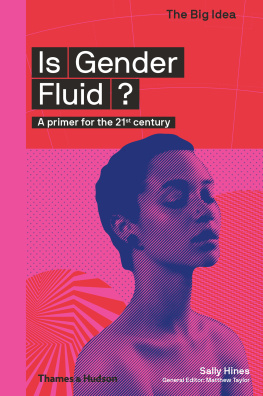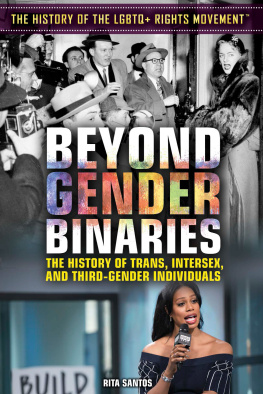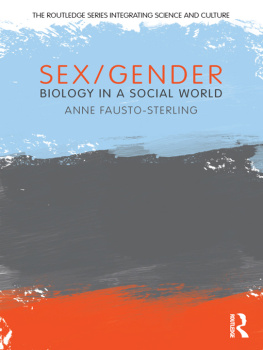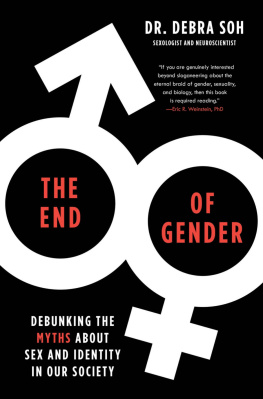GENDER
WHAT EVERYONE NEEDS TO KNOW

Oxford University Press is a department of the University of Oxford. It furthers the Universitys objective of excellence in research, scholarship, and education by publishing worldwide. Oxford is a registered trade mark of Oxford University Press in the UK and certain other countries.
What Everyone Needs to Know is a registered trademark of
Oxford University Press.
Published in the United States of America by Oxford University Press
198 Madison Avenue, New York, NY 10016, United States of America.
Oxford University Press 2021
All rights reserved. No part of this publication may be reproduced, stored in a retrieval system, or transmitted, in any form or by any means, without the prior permission in writing of Oxford University Press, or as expressly permitted by law, by license, or under terms agreed with the appropriate reproduction rights organization. Inquiries concerning reproduction outside the scope of the above should be sent to the Rights Department, Oxford University Press, at the address above.
You must not circulate this work in any other form and you must impose this same condition on any acquirer.
Library of Congress Cataloging-in-Publication Data
Names: Erickson-Schroth, Laura, author. | Davis, Benjamin, author.
Title: Gender : what everyone needs to know /
Laura Erickson-Schroth & Benjamin Davis.
Description: New York, NY : Oxford University Press, [2021] |
Series: What everyone needs to know | Includes bibliographical references and index.
Identifiers: LCCN 2020020674 (print) | LCCN 2020020675 (ebook) |
ISBN 9780190880033 (hardback) | ISBN 9780190880026 (paperback) |
ISBN 9780190880057 (ebook)
Subjects: LCSH: Gender identity. | Gender expression. |
Gender nonconformity. | Sex role. | Sex differences.
Classification: LCC HQ18.55 .E75 2021 (print) |
LCC HQ18.55 (ebook) | DDC 305.3dc23
LC record available at https://lccn.loc.gov/2020020674
LC ebook record available at https://lccn.loc.gov/2020020675
Contents
First of all, Id like to thank my co-author, Ben, who is not only a great writer but a wonderful human being. Making the decision to work on a project like this with a friend was a brave one for both of us. There were moments when I had to apologize profusely for missing deadlines, and somehow he forgave me. I love him more than I did before we started, which I didnt think was possible.
My mother, Nancy S. Erickson, JD, LLM, MA, was immensely helpful during this project. She is a lawyer with extensive knowledge of womens legal history and has been editing my writing since I learned how to write. In addition to providing feedback on parts of this book, she also wrote the first draft of the section on womens legal rights.
Finally, thank you to Abby, who is a true partner to me in every sense of the word. I dont think there is anything in life we cant accomplish together.
Laura
I owe tremendous gratitude to Laura, my co-author. This book was her vision, and I am humbled to have been included in it. Lauras incredible knowledge and clarity is certainly what allowed this book to make it to print. Thank you, Laura, for your brilliance, humor, and dedication.
Thank you to Clare, Maddie, Caty, Ember, Julia, Jess, Beck, Annie, and Todd, who provided endless encouragement and love, always.
To transgender and gender diverse people across the globe who demonstrate daily the beauty in difference, thank you.
Ben
Gender is all around us. Beliefs about gender impact our jobs, families, schools, religions, laws, politics, relationships, sports, clothes, and so much more. Gender permeates almost every aspect of our lives as humans.
Although this book is part of a series called What Everyone Needs to Know, it would be impossible to cover everything known about gender in one book, and since gender is something we all have in common and at the same time all experience differently, a consensus on the most important parts of gender differs based on personal experience and interest. In this book, weve tried to give you the highlights, so that you can dig deeper on your own if you hit a topic thats interesting to you.
With a book like this, there is always the question of what to include. Given space limitations, by making a decision to cover a topic, we have also made a choice not to cover another topic. And who are we to decide? Inevitably, we have left things out that authors from a different social or political background might have included.
Because gender is omnipresent, it is intertwined with so many other facets of our identities and lives. We cannot talk about gender without talking about race or class, for instance. Although we are not the experts on these intersections, we have attempted to identify the most crucial conversations so that readers are aware that they are happening.
Gender, and the words we used to describe it, depend on where we live and who we interact with. They are also constantly evolving. Still, there are terms that are important to know to have a common language to start from.
Gender is an individual and social experience, as opposed to sex, which is determined by chromosomes and hormones. To complicate things, there are overlaps between these two concepts, and there is evidence that gender may be biologically influenced. An individuals sex may be male, female, or intersex. Those who are intersex may have chromosomes or hormones that vary from expected binary combinations.
Gender identity is a persons inner sense of their gender as male, female, or something else. Gender roles reflect societal expectations for behaviors based on gender. A persons gender expression involves their mode of demonstrating gender to the world, through clothing, hair style, and mannerisms.
Transgender, or trans, people are those whose gender identities are different from their genders assigned at birth. Those who are cisgender have gender identities that match their assigned genders. Some people identify as nonbinary, meaning that they do not see themselves as either a man or a woman, but something outside of or in-between these. Binary transgender people typically use traditional pronouns such as he/him or she/her, while nonbinary individuals may use other pronouns, including they/them or ze/hir.
Sexual orientation is separate from gender identity and reflects the genders or sexes of the people someone is attracted to. The acronym LGBTQ is typically expanded as lesbian, gay, bisexual, transgender, and queer or questioning and may have additional letters added depending on the situation.
Lesbians are those who identify as women and are attracted to other women. Gay is a more gender-neutral term and can apply to anyone who is attracted to those with the same gender identity as themselves. Straight people are men attracted to women, or vice versa. Bisexual refers to those who are attracted to more than one gender. Pansexual is becoming a more popular term to describe similar attractions and, for some, signifies a less binary approach to sexuality. There are also those who identify as asexual and may have relationships but do not feel sexually attracted to others.
Queer is a complicated term that was reclaimed after originally being used as a slur. In some contexts, it is politicalsignifying a resistance to traditional expectationswhile in other situations, it is more of an umbrella term to describe those who are not straight, and sometimes, those who are not cisgender.














